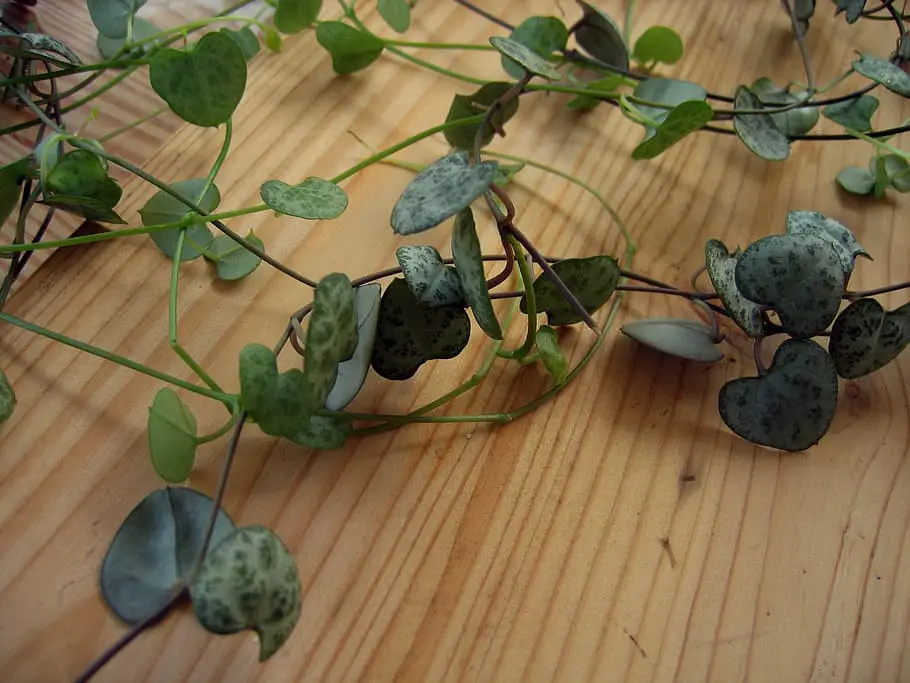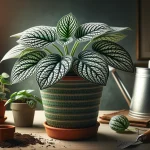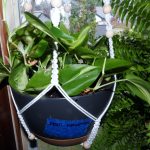This post may contain affiliate links. If you buy something from one of our links we may earn a commission. Thanks
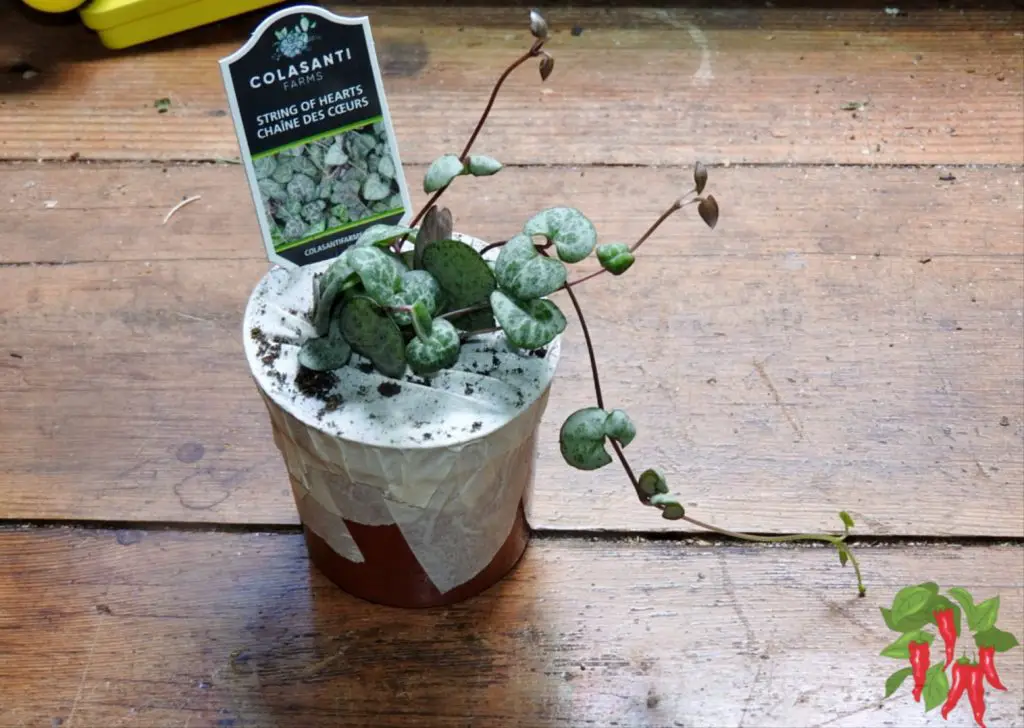
String of Hearts Care can seem tricky at first, but don’t worry—your heart-shaped beauty can thrive with the right attention!
Struggling with tangled vines or sparse leaves? Let’s dive into simple, effective tips to keep your plant healthy and flourishing.
String of Hearts Care Key Takeaways
- String of Hearts Care involves providing bright, indirect light.
- Water when the soil is dry, and ensuring good drainage.
- Maintain moderate humidity and temperature for optimal growth.
- Propagate easily with cuttings or tubers for a fuller plant.
My String of Hearts Plant
Here’s my String of Hearts – Hearts Entangled -Ceropegia woodii-2.5
I was on the lookout for some interesting hanging plants and found this String of Hearts plant on Amazon.
It was cheap and I took a gamble on it. Although it was small it arrived carefully packed and in great condition.
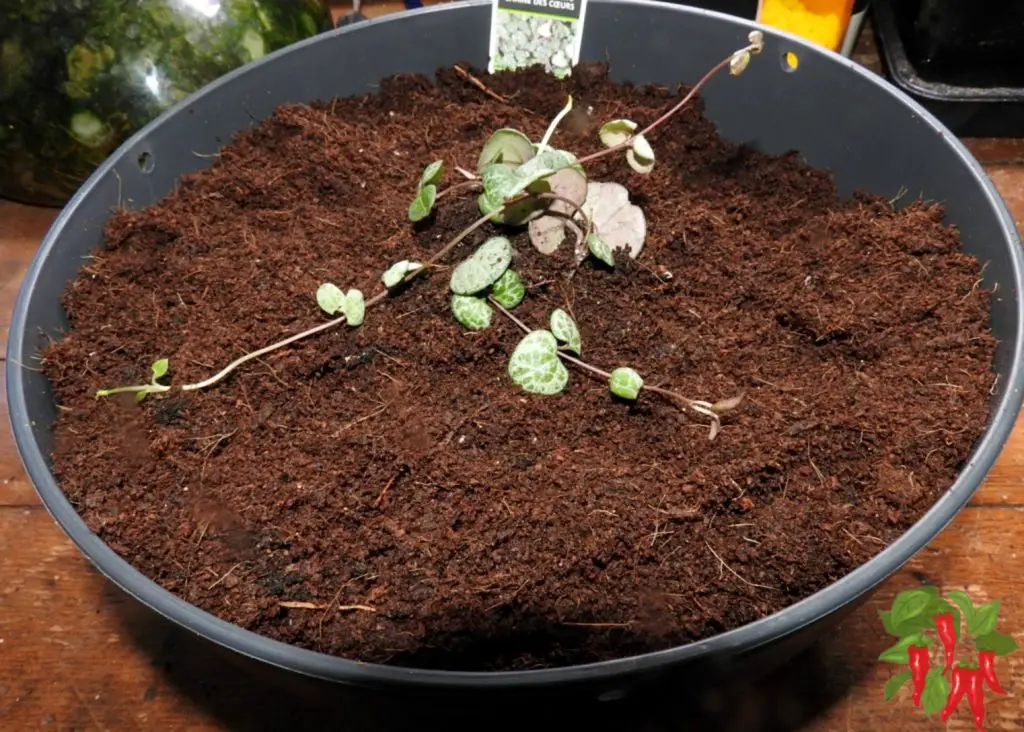
I have a 10-inch hanging planter that I am using for this plant. So I filled it with straight coco coir and set the plant in the center.
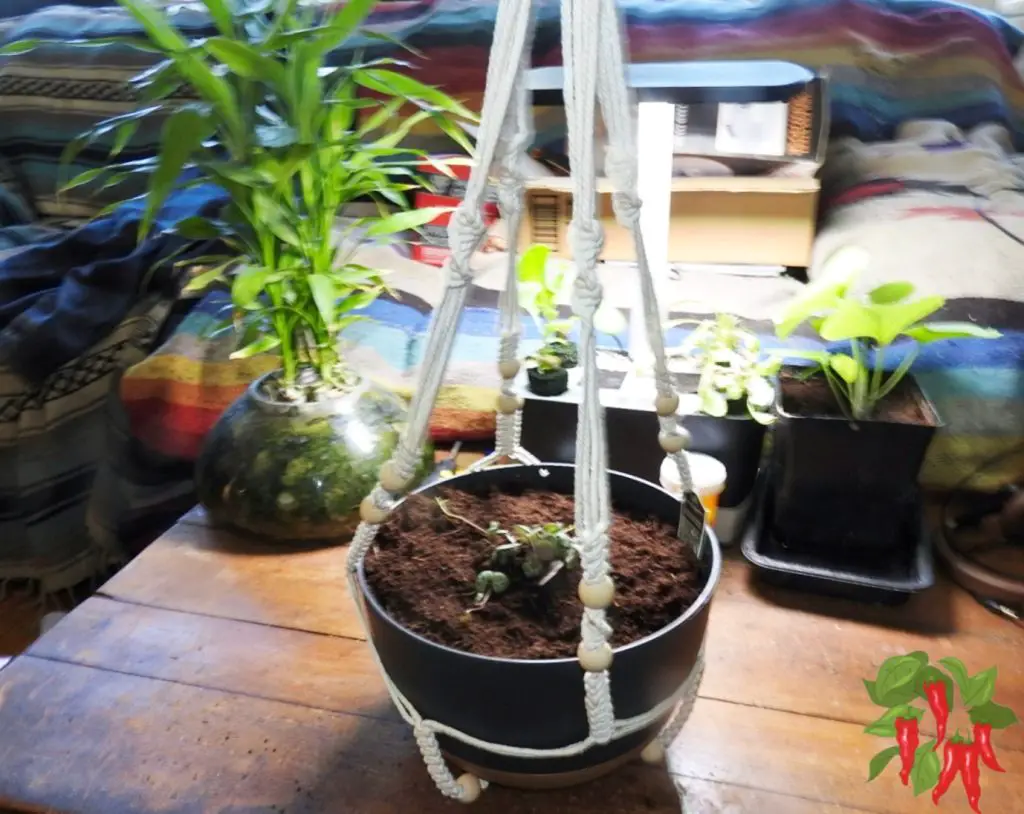
It’s here in the planter. Lots of room to grow. I need to water sparingly until it starts to fill the pot.
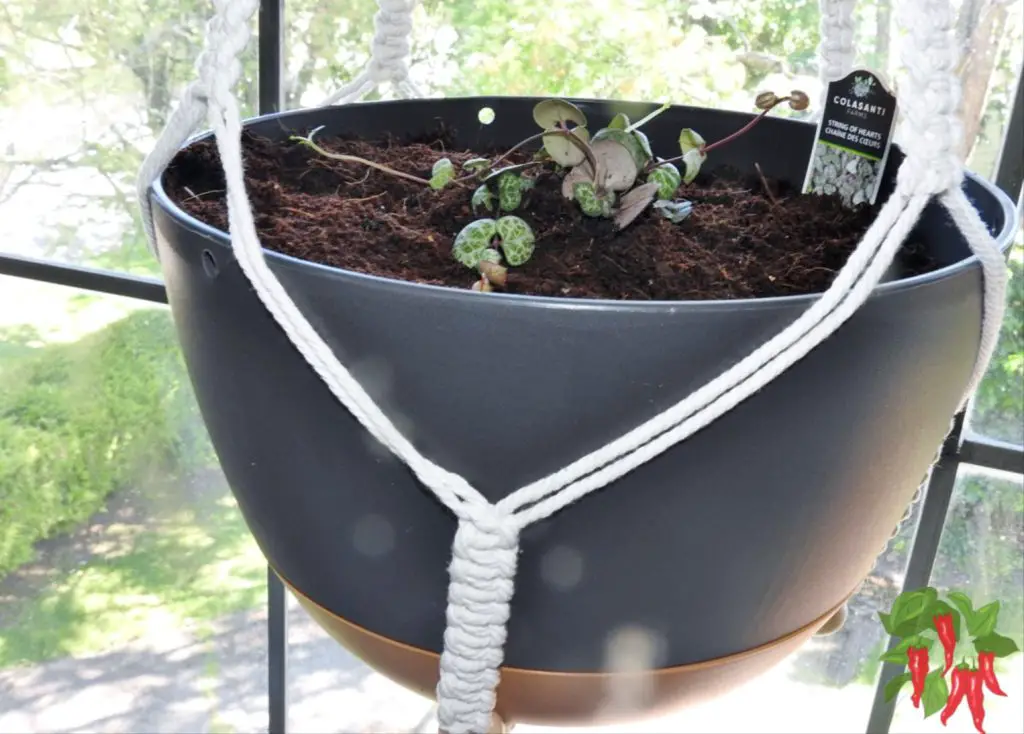
Here it is hanging in my window. It is a south-facing window but my house has long overhanging eaves so it will only get full sun in dead of winter when the sun is low in the sky.
So I will be growing my String of Hearts plant right along with the rest of you. I will update as time goes on.
String of Hearts Care

Howdy everyone! String of Hearts care is all about understanding the needs of this charming plant.
It thrives on bright, indirect light, careful watering, and the right temperature. With a bit of attention, your String of Hearts will flourish, adding a touch of elegance with its heart-shaped leaves.
Ready to dive into some simple, effective tips? Let’s get started and ensure your plant stays happy and healthy!
Introduction to String of Hearts Plant Care
Howdy everyone! If you’re looking to add a touch of charm to your indoor garden, the String of Hearts plant, also known as Ceropegia woodii, is a perfect choice.
Its delicate, heart-shaped leaves and trailing vines make it a favorite among plant enthusiasts. Let’s dive into the basics of caring for this lovely plant.
Overview of String of Hearts (Ceropegia woodii)
The String of Hearts is a trailing succulent native to South Africa. It’s known for its distinctive heart-shaped leaves and delicate vines.
This plant is not only beautiful but also relatively easy to care for, making it a popular choice for both novice and experienced gardeners.
Ceropegia woodii is a flowering plant in the dogbane family Apocynaceae, native to South Africa, Eswatini and Zimbabwe. It is sometimes treated as a subspecies of the related Ceropegia linearis, as C. linearis subsp. woodii. Common names include chain of hearts, collar of hearts, string of hearts, rosary vine, hearts-on-a-string, and sweetheart vine. https://en.wikipedia.org/wiki/Ceropegia_woodii
- Scientific Name: Ceropegia woodii
- Common Names: String of Hearts, Rosary Vine
- Native Habitat: South Africa
Popularity as a Houseplant
The String of Hearts has gained popularity as a houseplant for several reasons. Its unique appearance, with cascading vines that can grow several feet long, makes it an eye-catching addition to any room. Plus, its care requirements are quite simple, making it a great option for busy folks or those new to plant care.
-
- Unique Appearance: The heart-shaped leaves are not only cute but also add a whimsical touch to your home decor.
- Easy Care: This plant thrives with minimal fuss, needing just the right amount of light, water, and occasional fertilizing.
String of Hearts Plant Benefits
The String of Hearts plant is not only a charming addition to your home but also brings several benefits that make it a fantastic choice for any indoor garden.
Let’s explore why this plant is so beloved and what makes it a great pick for plant enthusiasts.
Aesthetic Appeal and Decorative Uses
The String of Hearts plant is known for its stunning, heart-shaped leaves and trailing vines. These unique features make it an excellent decorative piece for any room.
It is also called Rosary Vine because of the round bead-like tubers it produces.
What intrigued me most about these plants was the flowers. They look like Nepenthes pitchers with wicked forked tongues coming up from the center.
Whether you hang it in a basket or let it trail down a shelf, it adds a whimsical touch to your home decor.
The delicate vines can grow several feet long, creating a cascading effect that is both elegant and eye-catching.
- Unique Look: Heart-shaped leaves and long, trailing vines.
- Versatile Decor: Ideal for hanging baskets, shelves, or as part of a plant arrangement.
Air Purification Qualities
While the String of Hearts is primarily valued for its beauty, it also helps purify the air. Like many houseplants, it can help remove toxins from the air, improving indoor air quality.
This makes it not only a visual delight but also a practical addition to your home, contributing to a healthier living environment.
- Improves Air Quality: Helps remove toxins from the air.
- Health Benefits: Contributes to a cleaner, healthier indoor environment.
Low Maintenance Requirements
One of the best things about the String of Hearts plant is its low maintenance needs. It’s perfect for both novice gardeners and busy individuals.
This plant thrives with minimal care, requiring only occasional watering and fertilizing.
It’s drought-tolerant and can adapt to various light conditions, making it a resilient and easy-to-care-for houseplant.
- Easy Care: Requires minimal watering and attention.
- Drought-Tolerant: Can withstand periods of dryness.
- Adaptable: Thrives in various light conditions.
Benefits Key Takeaways
- Aesthetic Appeal: Heart-shaped leaves and trailing vines add a whimsical touch.
- Air Purification: Helps remove toxins and improve indoor air quality.
- Low Maintenance: Easy to care for, drought-tolerant, and adaptable to various light conditions.
String of Hearts Care: Light
Getting the light conditions right is key when it comes to String of Hearts care. This plant thrives in bright, indirect light, which helps it grow those lovely, heart-shaped leaves and long, trailing vines.
Let’s break down the ideal light conditions, the effects of too much or too little light, and how to find the perfect spot in your home.
Ideal Light Conditions
String of Hearts plants love bright, indirect light. This means they do best in a location where they get plenty of natural light without being exposed to direct sunlight for extended periods.
Direct sun can scorch their delicate leaves, while too little light can make them leggy and sparse.
- Ideal Light: Bright, indirect light
- Avoid: Direct midday sun, which can burn the leaves
Effects of Insufficient and Excessive Light
Getting the light just right is crucial for keeping your String of Hearts healthy.
- Insufficient Light: When the plant doesn’t get enough light, it can become leggy, with long, thin vines and fewer leaves. The beautiful heart-shaped leaves may also lose their vibrant color and start to fade.
- Excessive Light: On the other hand, too much direct sunlight can cause the leaves to burn and turn brown at the edges. The plant may also start to look wilted and stressed.
Tips for Finding the Right Spot in Your Home
Finding the perfect spot for your String of Hearts can make a big difference in its health and appearance. Here are some tips to help you out:
- Near a Window: Place your plant near a window that gets plenty of bright, indirect light. East or west-facing windows are often ideal.
- Sheer Curtains: If you only have windows with direct sunlight, use sheer curtains to diffuse the light and protect the plant from sunburn.
- Rotate Regularly: Rotate the plant every few weeks to ensure all sides get equal light and prevent it from growing unevenly.
- Artificial Light: If natural light is limited, you can supplement with a grow light. Just make sure it’s not too intense.
Light Key Takeaways
- Ideal Light: Bright, indirect light is perfect.
- Effects of Light: Too little light makes it leggy, too much burns the leaves.
- Best Spots: Near east or west-facing windows, or use sheer curtains and rotate the plant regularly.
String of Hearts Care: Water
Howdy everyone! Proper watering is crucial for keeping your String of Hearts healthy and happy.
This plant is somewhat drought-tolerant, but it still has specific watering needs.
Let’s go over how often to water, signs of overwatering and underwatering, and how to adjust your watering routine with the seasons.
Watering Frequency and Methods
String of Hearts plants prefer to have their soil dry out between waterings. Overwatering can lead to root rot, while underwatering can cause the leaves to shrivel.
- Watering Schedule: Water when the top inch of the soil feels dry. This usually means watering every one to two weeks, depending on your home’s humidity and temperature.
- Method: Water thoroughly until it drains out of the bottom of the pot, then let the soil dry completely before the next watering. Make sure your pot has drainage holes to prevent standing water.
Signs of Overwatering and Underwatering
It’s important to recognize the signs of both overwatering and underwatering to adjust your care routine accordingly.
- Overwatering: Look for yellowing leaves, a mushy texture, and an overall wilted appearance. If the soil is consistently wet or soggy, root rot can develop.
- Underwatering: The leaves may become dry, shriveled, and crispy. The plant might also drop some leaves if it’s too dry for extended periods.
Tips for Seasonal Watering Adjustments
Your String of Hearts will need different amounts of water depending on the season.
- Spring and Summer: During the growing season, your plant will need more frequent watering. Keep an eye on the soil and water when the top inch is dry.
- Fall and Winter: Growth slows down in cooler months, so reduce watering. Allow the soil to stay dry a bit longer between waterings, but don’t let it become bone dry for too long.
Watering Key Takeaways
- Watering Frequency: Water when the top inch of soil is dry.
- Overwatering Signs: Yellowing, mushy leaves, and wilted appearance.
- Underwatering Signs: Dry, shriveled, and crispy leaves.
- Seasonal Adjustments: More frequent watering in spring and summer; less in fall and winter.
String of Hearts Care: Humidity
Maintaining the right humidity level is an important part of String of Hearts care. While this plant is quite adaptable, providing the optimal humidity can help it thrive and grow beautifully.
Let’s chat about the humidity preferences of the String of Hearts, how to maintain the ideal humidity and the effects of high and low humidity on the plant.
Humidity Preferences
String of Hearts plants prefer moderate humidity levels. They can tolerate average household humidity, but they flourish in environments with slightly higher moisture levels.
- Ideal Humidity: Moderate, around 40-50%
- Tolerable Range: 30-60%, typical of most indoor environments
How to Maintain Optimal Humidity
Keeping the humidity just right can be simple with a few tips and tricks.
- Humidifiers: Using a room humidifier can help maintain consistent humidity, especially in dry climates or during winter when indoor air tends to be drier.
- Pebble Trays: Place a tray filled with water and pebbles under the plant’s pot. As the water evaporates, it increases the humidity around the plant.
- Grouping Plants: Grouping your plants together can create a microenvironment with higher humidity, as plants release moisture into the air.
- Misting: Occasionally misting the plant can help, but avoid overdoing it to prevent mold or mildew on the leaves.
Effects of High and Low Humidity
Understanding how humidity affects your String of Hearts can help you adjust conditions as needed.
- High Humidity: Excessive humidity can lead to fungal issues and root rot if the soil remains too wet. Ensure good air circulation to prevent these problems.
- Low Humidity: If the air is too dry, the leaves may become crispy and shriveled. The plant might also drop leaves as a stress response.
Humidity Key Takeaways
- Ideal Humidity: Moderate levels around 40-50%.
- Maintaining Humidity: Use humidifiers, pebble trays, group plants, and occasional misting.
- Effects of Humidity: High humidity can cause fungal issues; low humidity can dry out the leaves.
String of Hearts Care: Temperature
Temperature is another key factor in caring for your String of Hearts plant. This lovely trailing plant prefers a specific temperature range to thrive and grow.
Let’s talk about the ideal temperatures, how to protect your plant from extremes, and some seasonal temperature care tips.
Preferred Temperature Range
String of Hearts plants flourish in warm, stable temperatures. They prefer a range of 60-85°F (15-29°C).
- Optimal Range: 60-85°F (15-29°C)
- Minimum Tolerance: Can occasionally handle temperatures as low as 55°F (12°C), but not for extended periods
How to Protect from Temperature Extremes
Extreme temperatures can stress your String of Hearts, so it’s important to shield it from both heat and cold.
- Heat Protection: Keep your plant away from direct sun during the hottest part of the day, especially in summer. Avoid placing it near heaters or radiators.
- Cold Protection: Ensure your plant is not exposed to drafts from windows, doors, or air conditioning vents. During colder months, move it away from chilly windows and ensure it’s in a warm spot.
Seasonal Temperature Care Tips
Adjusting your care routine according to the seasons can help keep your String of Hearts healthy year-round.
- Spring and Summer: During these warmer months, ensure the plant is in a spot where it gets plenty of indirect light but is protected from intense midday sun. Regularly check for signs of heat stress.
- Fall and Winter: As temperatures drop, move your plant to a warmer location away from drafts. Reduce watering since the plant’s growth slows down and it needs less moisture.
Temperature Key Takeaways
- Preferred Temperature: 60-85°F (15-29°C)
- Protect from Extremes: Shield from direct heat sources and drafts.
- Seasonal Care: Adjust placement and watering according to seasonal changes.
String of Hearts Care: Soil
Getting the soil right for your String of Hearts is crucial for its health and growth. This plant thrives in a well-draining, light, and aerated soil mix.
Let’s dive into the best soil mix, how to improve drainage and some handy repotting tips.
Best Soil Mix for String of Hearts
String of Hearts plants do best in a soil mix that drains quickly and doesn’t retain too much moisture. A cactus or succulent mix is often ideal because it’s designed to be well-draining and light.
- Ideal Soil Mix: Use a cactus or succulent mix.
- Components: A good mix typically includes ingredients like perlite, coarse sand, and peat moss or coconut coir.
Soil Amendments to Improve Drainage
Improving the drainage of your soil mix is essential to prevent root rot and other moisture-related issues. Here are some amendments you can add to your soil:
- Perlite: Helps aerate the soil and improve drainage.
- Coarse Sand: Increases the soil’s ability to drain quickly.
- Pumice or Crushed Granite: Adds extra drainage and helps prevent soil compaction.
Repotting Tips and Frequency
Repotting your String of Hearts helps refresh the soil and gives the roots more space to grow. Here’s how and when to do it:
- Frequency: Generally, repot every 2-3 years or when you notice the plant becoming root-bound (roots growing out of the drainage holes).
- Best Time to Repot: Spring or early summer, during the plant’s active growing season.
- Steps for Repotting:
- Prepare the New Pot: Choose a pot that’s one size larger than the current one and has drainage holes.
- Remove the Plant: Gently squeeze the sides of the current pot to loosen the soil and carefully lift the plant out.
- Refresh the Soil: Shake off the old soil from the roots and inspect them for any signs of rot or damage.
- Plant in New Soil: Place the plant in the new pot, fill with fresh soil mix, and water lightly.
Repotting Key Takeaways
- Best Soil Mix: Use a well-draining cactus or succulent mix.
- Soil Amendments: Add perlite, coarse sand, or pumice for better drainage.
- Repotting: Do it every 2-3 years, preferably in spring or early summer.
String of Hearts Care: Fertilizer
Feeding your String of Hearts plant the right way can make a big difference in its growth and overall health.
Let’s go over the fertilization schedule, the types of fertilizer to use, the importance of balanced nutrients, and how to recognize and fix over-fertilization.
Fertilization Schedule and Types of Fertilizer to Use
String of Hearts plants benefit from regular feeding during their active growing season, which typically runs from spring to early fall.
Here’s how to keep your plant well-fed:
- Schedule: Fertilize once a month during the growing season (spring to early fall).
- Type of Fertilizer: Use a balanced, water-soluble fertilizer. A formula like 20-20-20 or a specific succulent/cactus fertilizer works well.
Importance of Balanced Nutrients
Providing balanced nutrients is crucial for the health and growth of your String of Hearts. Here’s why:
- Nitrogen (N): Supports leaf growth and overall health.
- Phosphorus (P): Promotes root development and flower production.
- Potassium (K): Enhances overall plant vigor and disease resistance.
Using a balanced fertilizer ensures that your plant gets all the essential nutrients it needs in the right proportions.
Signs of Over-Fertilization and How to Address Them
Over-fertilizing can harm your String of Hearts by causing nutrient burn, root damage, and poor growth. Here are some signs to look out for and how to fix them:
- Signs of Over-Fertilization:
- Yellowing or browning of leaf edges.
- Wilting or drooping leaves despite adequate watering.
- White crust on the soil surface (salt buildup).
- Stunted growth or sudden leaf drop.
- How to Address Over-Fertilization:
- Flush the Soil: Water the plant thoroughly to flush out excess fertilizer salts. Let the water run through the soil and drain completely.
- Reduce Feeding: Cut back on the frequency and amount of fertilizer. Consider switching to a more diluted solution.
- Repot if Necessary: If the soil has a severe salt buildup, consider repotting the plant with fresh soil.
Fertilizer Key Takeaways
- Fertilization Schedule: Feed once a month during the growing season.
- Type of Fertilizer: Use a balanced, water-soluble fertilizer.
- Balanced Nutrients: Ensure your fertilizer provides a good mix of nitrogen, phosphorus, and potassium.
- Over-Fertilization: Look out for yellowing leaves and salt buildup; flush the soil and adjust feeding as needed.
String of Hearts Care: Propagation
Howdy everyone! Propagating your String of Hearts is a fun and rewarding way to grow more of these charming plants.
Whether you use cuttings or tubers there are several methods to choose from.
Let’s go through the step-by-step guides for each method and some tips for successful propagation.
Methods of Propagation
There are three main ways to propagate String of Hearts: cuttings, tubers, and seeds.
- Cuttings: The most common and easiest method.
- Tubers: Using the small bulb-like structures that form along the vines.
- Seeds: Less common but possible if you can find seeds.
Step-by-Step Guides for Each Method
1. Propagating by Cuttings:
- Choose a Healthy Vine: Select a healthy vine with at least a few pairs of leaves.
- Cut the Vine: Using clean, sharp scissors, cut a 3-4 inch section just below a node.
- Remove Lower Leaves: Strip off the leaves from the lower part of the cutting to expose the nodes.
- Plant in Soil or Water:
- Soil: Plant the cutting in a well-draining soil mix. Water lightly.
- Water: Place the cutting in a jar of water, ensuring the nodes are submerged. Change the water regularly.
2. Propagating by Tubers:
- Identify Tubers: Look for small, bulb-like tubers along the vines.
- Prepare the Pot: Fill a pot with a succulent or cactus mix.
- Lay the Vine: Lay the vine with the tuber on the soil surface and gently press it down. You can take them off the vine and plant them separately too.
- Secure the Vine: Use a hairpin or a small piece of wire to pin the vine to the soil.
- Water and Wait: Keep the soil moist but not soggy. Roots will form from the tuber in a few weeks.
3. Propagating by Seeds:
- Get Seeds: If you can find seeds, they can be sown in a light, well-draining seed-starting mix.
- Sow Seeds: Scatter the seeds on the surface of the moist soil and press them in lightly.
- Cover and Wait: Cover with a plastic dome or bag to maintain humidity. Place in a bright, indirect light location.
- Germination: Seeds should germinate in 2-4 weeks. Gradually acclimate the seedlings to normal humidity once they have sprouted.
Tips for Successful Propagation
- Sterilize Tools: Always use clean, sharp tools to prevent infection.
- Humidity: Keep the cuttings or seeds in a humid environment to encourage rooting.
- Light: Provide bright, indirect light to promote healthy growth.
- Patience: Propagation can take a few weeks to a few months, so be patient and monitor progress regularly.
PropagationKey Takeaways
- Methods: Cuttings, tubers, seeds.
- Steps for Cuttings: Cut a vine, remove lower leaves, plant in soil or water.
- Steps for Tubers: Pin tuber to soil, keep moist.
- Steps for Seeds: Sow on moist soil, cover, and wait.
- Tips: Use clean tools, maintain humidity, provide bright light, be patient.
String of Hearts Care: Problems
Howdy everyone! Even with the best care, your String of Hearts plant can sometimes face problems.
These can range from pests and diseases to environmental stress. Let’s explore some common issues, how to identify and treat pests, and preventive measures for common diseases.
Common Issues
String of Hearts plants can be susceptible to several problems, including pests, diseases, and environmental stress. Here are the most common ones:
- Pests: Mealybugs, aphids, and spider mites are the usual suspects.
- Diseases: Root rot and fungal infections can occur, especially with overwatering.
- Environmental Stress: Issues like sudden changes in temperature, drafts, or improper light can stress the plant.
Identification and Treatment of Pests
Mealybugs:
- Identification: Look for white, cottony clusters on the leaves and stems.
- Treatment: Use a cotton swab dipped in rubbing alcohol to remove them. You can also use insecticidal soap or neem oil.
Aphids:
- Identification: Small, soft-bodied insects often found on new growth. They can be green, black, brown, or red.
- Treatment: Spray the plant with water to dislodge them, or use insecticidal soap or neem oil.
Spider Mites:
- Identification: Tiny, spider-like creatures that create fine webbing on the plant. Leaves may become speckled or discolored.
- Treatment: Increase humidity around the plant and spray with insecticidal soap or neem oil. Regularly wipe leaves with a damp cloth.
Preventive Measures and Solutions for Common Diseases
Root Rot:
- Prevention: Ensure proper drainage by using a well-draining soil mix and pots with drainage holes. Avoid overwatering.
- Solution: If you notice root rot, remove the plant from the pot, cut away affected roots, and repot in fresh, dry soil. Reduce watering frequency.
Fungal Infections:
- Prevention: Maintain good air circulation and avoid getting water on the leaves.
- Solution: Remove affected leaves and treat with a fungicide if necessary. Ensure the plant is not overcrowded and has plenty of space to breathe.
String of Hearts Problems Key Takeaways
- Common Issues: Pests, diseases, environmental stress.
- Pest Identification and Treatment: Mealybugs, aphids, spider mites.
- Preventive Measures: Proper drainage, good air circulation, and avoiding overwatering.
String of Hearts Care: Plant Poisonous
If you have pets or young children at home, it’s important to know whether your plants pose any risks.
The String of Hearts plant, while beautiful, does come with some toxicity concerns. Let’s dive into its toxicity to pets and humans, symptoms of poisoning, and some safety tips for households with pets.
Toxicity to Pets and Humans
The String of Hearts plant (Ceropegia woodii) is considered to be mildly toxic to both pets and humans. Ingesting parts of the plant can lead to gastrointestinal discomfort.
- Pets: Cats and dogs may experience symptoms like vomiting, diarrhea, and general discomfort if they chew on the plant.
- Humans: While less common, ingestion can cause mild stomach upset.
Symptoms of Poisoning
Recognizing the symptoms of poisoning can help you act quickly and get the necessary help.
-
In Pets:
- Vomiting
- Diarrhea
- Drooling
- Lack of appetite
-
In Humans:
- Nausea
- Vomiting
- Stomach pain
Safety Tips for Households with Pets
Keeping your String of Hearts plant out of reach of curious pets and children can prevent accidental ingestion.
- Placement: Hang the plant in a high location or place it on a tall shelf where pets and small children can’t reach.
- Training: Train your pets to avoid chewing on plants. Providing alternative chew toys can help.
- Supervision: Keep an eye on pets when they are in rooms with houseplants.
Toxicity Key Takeaways
- Toxicity: Mildly toxic to pets and humans.
- Symptoms: Vomiting, diarrhea, nausea, and stomach pain.
- Safety Tips: Place the plant out of reach, train pets, and supervise them around houseplants.
String of Hearts Care: Varieties
Howdy everyone! The String of Hearts plant isn’t just limited to one type. There are several beautiful varieties, each with its own unique characteristics. Let’s explore some of these varieties and the specific care they might require.
Different Types of String of Hearts
Variegated String of Hearts (Ceropegia woodii variegata)
- Description: This variety features green leaves with cream, pink, and silver variegation. The striking patterns make it a popular choice among plant enthusiasts.
- Care Differences: Slightly more light may enhance the variegation, but avoid direct sunlight to prevent leaf burn.
Silver Glory (Ceropegia woodii ‘Silver Glory’)
- Description: Known for its silver-hued leaves with a darker green line along the edges, giving it a more metallic appearance.
- Care Differences: Similar care to the standard variety, but ensure bright, indirect light to maintain the vibrant silver coloration.
Heartless (Ceropegia woodii ‘Heartless’)
- Description: Also known as String of Spades, this variety has bright green leaves with a distinctive spade-like shape and pink undersides.
- Care Differences: This variety thrives with the same care as other types but benefits from regular pruning to maintain its shape and fullness.
Orange River
- Description: This type features green leaves with an orange tint, adding a warm hue to the plant.
- Care Differences: Ensure bright, indirect light to keep the orange tint vibrant and avoid overwatering.
String of Needles (Ceropegia linearis)
- Description: Unlike the heart-shaped leaves of other varieties, this one has needle-like foliage, providing a different texture and look.
- Care Differences: Similar care to other varieties but may require more frequent watering due to its thinner leaves.
Unique Characteristics of Each Variety
- Variegated String of Hearts: Striking variegation with pink and cream tones.
- Silver Glory: Metallic silver leaves with dark green edges.
- Heartless: Spade-shaped leaves with bright green tops and pink undersides.
- Orange River: Green leaves with an orange hue.
- String of Needles: Needle-like leaves providing a unique texture.
Care Differences Among the Varieties
While all varieties of String of Hearts require similar basic care, such as bright, indirect light and well-draining soil, there are a few nuances:
- Light Needs: Variegated varieties benefit from slightly more light to enhance their colors but still need to be protected from direct sunlight.
- Watering: Thinner-leaved varieties like String of Needles may need more frequent watering compared to thicker-leaved types.
- Pruning: Varieties like Heartless may need more regular pruning to maintain their shape and fullness.
Srting of Hearts Varieties Key Takeaways
- Varieties: Variegated, Silver Glory, Heartless, Orange River, String of Needles.
- Unique Characteristics: Each variety has distinct leaf shapes and colors.
- Care Differences: Adjust light and watering needs slightly based on the variety.
How to Make Your String of Hearts Fuller
If you’re looking to make your String of Hearts plant fuller and bushier, there are a few key techniques you can use.
From pruning and training to managing vine length, let’s explore how to enhance the fullness of this charming plant.
Pruning Techniques to Encourage Bushier Growth
Pruning is an effective way to encourage your String of Hearts to grow bushier. Regular pruning helps stimulate new growth and prevents the plant from becoming too leggy.
- Tip Pruning: Pinch off the growing tips of the vines regularly. This encourages the plant to produce new shoots from the sides, leading to a fuller appearance.
- Remove Leggy Growth: Cut back any overly long or sparse vines. This not only tidies up the plant but also promotes the growth of new, healthy stems.
- Pruning Timing: The best time to prune is during the growing season, typically in spring and summer, when the plant can recover and grow new foliage quickly.
Training Methods to Enhance Fullness
Training your String of Hearts can help it grow more compact and fuller. Here are some methods to try:
- Looping Vines: Gently loop the longer vines back into the pot. This encourages the plant to grow more leaves along the vine and helps fill out the pot.
- Support Structures: Use small trellises or hoops to guide the vines upward or across a surface. This not only enhances fullness but also adds visual interest.
- Pinning: Use hairpins or plant clips to pin sections of the vine to the soil. This can promote rooting at multiple points along the vine, leading to a fuller appearance.
Managing Vine Length for Aesthetic Appeal
Keeping your String of Hearts vines at an optimal length can improve the overall look of the plant and make it appear fuller.
- Regular Trimming: Trim the vines regularly to prevent them from getting too long and sparse. Focus on maintaining a balance between vine length and leaf density.
- Even Growth: Rotate the pot periodically to ensure even light exposure, which helps maintain uniform growth on all sides of the plant.
- Controlled Sprawl: Allow some vines to hang while training others to grow horizontally across the surface of the pot. This method creates layers and depth, enhancing the plant’s bushiness.
Pruning and Training Key Takeaways
- Pruning: Regularly pinch and trim vines to stimulate new growth.
- Training: Use looping, support structures, and pinning to enhance fullness.
- Vine Management: Keep vines at optimal lengths and ensure even growth for a fuller appearance.
Do String of Hearts Like to Climb or Hang?
The String of Hearts plant, with its delicate, heart-shaped leaves and long vines, can add charm to your home whether it’s climbing or hanging.
Let’s explore the growth habits and natural tendencies of this plant, best practices for supporting both climbing and hanging growth, and some creative display ideas.
Growth Habits and Natural Tendencies
The String of Hearts (Ceropegia woodii) is naturally a trailing plant. In its native habitat, it tends to grow along the ground or over rocks, but it can also climb when it has support. This dual nature makes it versatile for indoor gardening.
- Trailing Habit: Prefers to trail downwards, creating a cascading effect.
- Climbing Capability: Can climb if provided with a structure like a trellis or support poles.
Best Practices for Supporting Climbing or Hanging Growth
For Hanging Growth:
- Hanging Baskets: Place the plant in a hanging basket to allow its vines to trail down naturally.
- High Shelves: Position the plant on a high shelf so the vines can cascade down.
- Pruning: Regularly prune to encourage fuller growth and prevent the vines from becoming too leggy.
For Climbing Growth:
- Trellises and Poles: Use small trellises, poles, or a moss stick to train the vines to climb. Gently guide the vines onto the support structure.
- Tying Vines: Use soft ties or plant clips to secure the vines to the support, encouraging upward growth.
- Regular Adjustment: As the plant grows, continue to adjust and secure the vines to maintain their climbing path.
Display Ideas for Different Growth Styles
Hanging Style:
- Window Display: Hang the plant near a window where it can receive bright, indirect light. The trailing vines create a beautiful silhouette against the light.
- Corner Placement: Use hanging baskets in the corners of rooms to fill empty spaces with greenery.
- Macrame Hangers: Incorporate macrame plant hangers to add a boho touch to your decor.
Climbing Style:
- Bookshelves: Use the plant as a living curtain on bookshelves, allowing the vines to climb and drape over the edges.
- Room Dividers: Create a green wall or room divider by training the plant to climb a freestanding trellis.
- Wall Art: Attach a trellis or grid to the wall and let the plant grow upwards, creating living wall art.
Display Ideas Key Takeaways
- Growth Habits: Naturally trails but can climb with support.
- Hanging Practices: Use hanging baskets, high shelves, and regular pruning.
- Climbing Practices: Employ trellises, poles, and soft ties to guide upward growth.
- Display Ideas: Try window displays, corner placements, macrame hangers, bookshelves, room dividers, and wall art.
Should I Untangle My String of Hearts?
If you’ve ever owned a String of Hearts plant, you know how easily those beautiful vines can become tangled.
You might be wondering if you should untangle them and how to do it safely.
Let’s explore the benefits and drawbacks of untangling, how to safely manage the vines, and tips for preventing future tangles.
Benefits and Drawbacks of Untangling
Benefits:
- Improved Air Circulation: Untangled vines allow for better air circulation, which can help prevent fungal issues.
- Aesthetic Appeal: Neatly arranged vines look more attractive and can enhance the plant’s overall appearance.
- Healthier Growth: Reducing tangles can prevent damage to the vines and promote healthier growth.
Drawbacks:
- Risk of Damage: Untangling can sometimes lead to accidental breakage of the delicate vines.
- Time-Consuming: Depending on how tangled the plant is, the process can be quite time-consuming.
- Stress to the Plant: Frequent manipulation of the vines can stress the plant, especially if done incorrectly.
How to Safely Untangle Vines
Untangling your String of Hearts requires patience and a gentle touch. Here’s a step-by-step guide to help you:
- Prepare the Plant: Gently place the plant on a flat surface and spread out the vines as much as possible.
- Work Slowly: Start from the ends of the vines and work your way toward the base. Be patient and avoid pulling or tugging too hard.
- Use Tools: If needed, use small tools like a toothpick or tweezers to help separate tightly tangled sections.
- Cut if Necessary: If you encounter a knot that’s impossible to untangle without damaging the plant, consider cutting that section off. The plant can be propagated from the cuttings.
Tips for Preventing Tangling in the Future
To keep your String of Hearts looking neat and prevent future tangles, follow these tips:
- Regular Pruning: Regularly prune the plant to manage the length of the vines and encourage fuller growth. This can help reduce the chances of tangling.
- Proper Placement: Ensure the plant is placed where it has enough space for the vines to hang or climb without obstruction.
- Train the Vines: Use trellises, stakes, or other supports to guide the vines in a controlled manner. This helps prevent them from overlapping and tangling.
- Routine Checks: Periodically check and gently adjust the vines to keep them from becoming tangled.
Untangling Key Takeaways
- Benefits of Untangling: Better air circulation, aesthetic appeal, healthier growth.
- Drawbacks of Untangling: Risk of damage, time-consuming, potential stress to the plant.
- Safe Untangling: Work slowly, use small tools, cut if necessary.
- Preventing Tangles: Regular pruning, proper placement, training vines, routine checks.
Does String of Hearts Purify Air?
If you’re wondering whether the String of Hearts plant can help purify the air in your home, you’re in the right place.
Let’s explore the air purifying capabilities of this lovely plant, compare it with other popular houseplants, and share some best practices for maximizing air purification in your space.
Air Purifying Capabilities of String of Hearts
The String of Hearts plant, while primarily valued for its aesthetic appeal, does offer some air purifying benefits.
Like many houseplants, it can help remove certain toxins from the air, contributing to a healthier indoor environment.
However, it is not as effective as some other plants specifically known for their air purifying abilities.
- Minor Air Purification: Can help reduce minor pollutants and increase oxygen levels.
- Best for Decor: While it does offer some purification, its primary strength lies in its decorative appeal.
Comparison with Other Popular Houseplants
When it comes to air purification, some houseplants are more effective than others. Here’s a quick comparison:
1. Spider Plant (Chlorophytum comosum)
- Air Purifying Strength: Excellent at removing formaldehyde, xylene, and toluene.
- Care Level: Easy to care for, making it great for beginners.
2. Snake Plant (Sansevieria trifasciata)
- Air Purifying Strength: Known for removing formaldehyde, benzene, and other toxins.
- Care Level: Very low maintenance, tolerates low light and irregular watering.
3. Peace Lily (Spathiphyllum)
- Air Purifying Strength: Effective at removing ammonia, benzene, formaldehyde, and trichloroethylene.
- Care Level: Prefers low to moderate light and regular watering.
4. Boston Fern (Nephrolepis exaltata)
- Air Purifying Strength: Excellent at removing formaldehyde and xylene.
- Care Level: Requires consistent moisture and higher humidity.
Compared to these powerhouses, the String of Hearts offers some purification but is not as strong.
Best Practices for Maximizing Air Purification
To make the most of your String of Hearts and other houseplants for air purification, follow these best practices:
- Increase Plant Variety: Use a variety of air-purifying plants to cover a broader range of toxins.
- Plant Density: Increase the number of plants in your home. NASA’s Clean Air Study suggests that at least one plant per 100 square feet is beneficial.
- Healthy Plants: Keep your plants healthy with proper care, as healthy plants are more effective at air purification.
- Proper Placement: Place plants in areas where air circulation is high to maximize their purifying effects.
Key Takeaways
- Air Purifying Capability: String of Hearts offers minor purification.
- Comparison: More effective plants include Spider Plant, Snake Plant, Peace Lily, and Boston Fern.
- Best Practices: Use a variety of plants, increase plant density, keep plants healthy, and ensure proper placement.
String of Hearts Care Conclusion
Howdy everyone! Let’s wrap things up. Taking care of your String of Hearts plant can be a truly rewarding experience when you get the hang of it.
This charming little beauty, with its delicate heart-shaped leaves and trailing vines, can add a touch of elegance and greenery to any space in your home.
Wrapping Up String of Hearts Care
Here’s a comprehensive wrap-up to ensure your String of Hearts thrives and remains a stunning addition to your indoor garden.
By understanding its essential needs, you can provide an optimal environment for your plant:
- Light: Ensure your String of Hearts gets bright, indirect light. Too much direct sunlight can scorch its leaves, while too little light can lead to leggy growth. Finding the right balance will help maintain its vibrant and healthy appearance.
- Water: Watering your String of Hearts properly is crucial. Allow the soil to dry out between waterings to prevent root rot. Overwatering is a common mistake, so always check the soil moisture before watering again. During the growing season, water more frequently, and reduce watering in the cooler months.
- Humidity and Temperature: This plant prefers moderate humidity levels and a temperature range of 60-85°F (15-29°C). While it can tolerate average household humidity, providing a bit more moisture, especially in dry climates, will benefit its growth. Protect your plant from drafts and sudden temperature changes to avoid stress.
- Soil and Fertilizer: Use a well-draining soil mix, such as a cactus or succulent mix, to prevent water from sitting at the roots. Fertilize during the growing season with a balanced, water-soluble fertilizer to provide the necessary nutrients for healthy growth.
- Propagation: One of the joys of having a String of Hearts is propagating new plants. Whether you use cuttings, tubers, or seeds, propagating can be a fun and satisfying way to expand your collection or share with friends.
- Managing Problems: Keep an eye out for common issues like pests and diseases. Early detection and treatment can prevent problems from escalating. Regularly check for signs of mealybugs, aphids, and spider mites, and treat them promptly. Also, ensure good air circulation to prevent fungal issues.
By following these guidelines, you can create an environment where your String of Hearts can flourish.
Regular maintenance, including pruning and training, will keep your plant looking its best and encourage bushier growth.
Experimenting with different display options, such as hanging baskets or climbing supports, can also enhance its aesthetic appeal.
String of Hearts Care Key Takeaways
- Light: Bright, indirect light is ideal for healthy growth.
- Watering: Water when the soil is dry to the touch, allowing it to dry out between waterings.
- Humidity & Temperature: Maintain moderate humidity and a temperature range of 60-85°F (15-29°C).
- Soil & Fertilizer: Use a well-draining soil mix and fertilize during the growing season.
- Propagation: Easily propagate using cuttings, tubers, or seeds.
- Problem Management: Regularly check for pests and diseases, and address issues promptly.
In summary, taking care of a String of Hearts plant is straightforward and highly rewarding. By providing the right conditions and enjoying the process of care and propagation, you’ll have a thriving, beautiful plant that adds charm and greenery to your home. Happy gardening, and enjoy the journey with your String of Hearts!
That’s it for now, folks! Stay green and happy gardening!
Read more: Indoor Apartment Gardening: 15 Point Comprehensive Guide
Additional Sources:
(The Spruce) (Gardener’s Path) (Get Busy Gardening) (Leafy Place) (Own Yard Life) (Epic Gardening) (No Boring Plants) (PottedPlants).
Visit my Amazon Influencer Page for videos and gardening products Grow Your Own Garden


